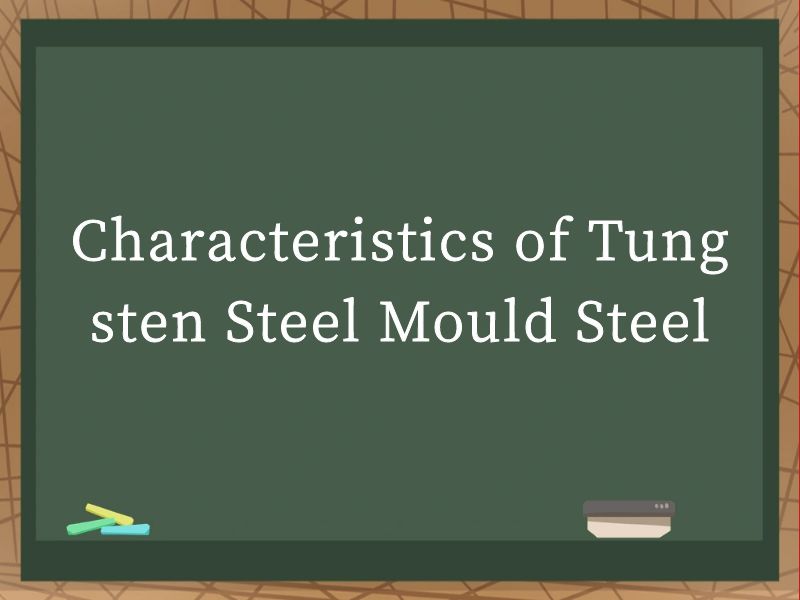JOURNALISM
- NEWS -
|
Characteristics of Tungsten Steel Mould SteelCharacteristics of Tungsten Steel Mould Steel.Tungsten steel mould steel, also known as high-speed steel, is a type of alloy steel renowned for its exceptional hardness, wear resistance, and ability to retain its cutting edge at high temperatures. This material has been extensively utilized in the manufacturing industry, particularly in the production of moulds and dies for various applications. Its unique characteristics make it indispensable in fields requiring precision and durability. This article delves into the detailed attributes of tungsten steel mould steel, exploring its composition, properties, processing techniques, and applications.
Composition and Alloying Elements Tungsten steel mould steel is composed primarily of iron (Fe), with significant additions of tungsten (W), carbon (C), chromium (Cr), vanadium (V), molybdenum (Mo), and cobalt (Co). The precise percentages of these elements can vary depending on the specific grade and intended use. However, tungsten is the key alloying element that gives the steel its name and distinctive properties. Tungsten is a refractory metal with a high melting point, which contributes to the steel's elevated temperature strength and hardness. Carbon, on the other hand, enhances the hardness and wear resistance of the steel by forming carbide particles within the microstructure. Chromium adds corrosion resistance and helps maintain the hardness at elevated temperatures. Vanadium and molybdenum further improve the red hardness, while cobalt increases the toughness and thermal fatigue resistance. Microstructure and Hardness The microstructure of tungsten steel mould steel consists of a complex arrangement of martensite, carbide particles, and retained austenite. Martensite is a hard phase formed during quenching, contributing to the steel's high hardness. Carbide particles, particularly tungsten carbide (WC), are dispersed throughout the matrix, providing wear resistance and edge retention. Retained austenite, which is a metastable phase, can transform into martensite during service, leading to secondary hardening and improved performance. The hardness of tungsten steel mould steel is typically measured on the Rockwell C scale (HRC). Depending on the heat treatment process, the hardness can range from 60 to 68 HRC. This high hardness, combined with its ability to maintain hardness at elevated temperatures (up to 600°C), makes it suitable for applications involving high-speed cutting and heavy loads. Wear Resistance and Durability Wear resistance is a critical property of tungsten steel mould steel, especially in applications where the material is subjected to abrasive and erosive wear. The carbide particles embedded within the steel's microstructure act as wear-resistant barriers, protecting the softer matrix from wear. This makes tungsten steel an excellent choice for producing moulds and dies that are used in the manufacture of plastic parts, metal castings, and other components requiring intricate shapes and high precision. Moreover, the durability of tungsten steel mould steel stems from its resistance to deformation and thermal fatigue. In moulding processes, the steel is exposed to cyclic heating and cooling, which can lead to thermal cracking and dimensional changes. Tungsten steel's high thermal conductivity and ability to retain its microstructure under these conditions ensure long-term stability and reliability. Heat Treatment and Processing The heat treatment of tungsten steel mould steel involves a series of carefully controlled processes, including annealing, quenching, and tempering. Annealing is performed to relieve internal stresses and soften the steel for machining. It involves heating the steel to a temperature below its critical point, holding it for a period, and then cooling it slowly. Quenching is the next step, where the steel is rapidly cooled from the austenitizing temperature to lock in the martensitic structure. This process significantly increases the hardness and wear resistance of the steel. However, quenching can also introduce residual stresses and brittleness, which must be addressed through tempering. Tempering involves heating the quenched steel to a temperature below the critical point and holding it for a specified time to relieve stresses and improve toughness. The temperature and duration of tempering can be adjusted to balance hardness and toughness according to the application requirements. After heat treatment, tungsten steel mould steel can be machined and polished to the desired shape and finish. However, due to its high hardness, machining can be challenging and requires specialized tools and techniques. Precision grinding, electrical discharge machining (EDM), and laser cutting are commonly used methods for shaping and finishing tungsten steel mould steel. Applications in the Manufacturing Industry Tungsten steel mould steel finds widespread application in the manufacturing industry, particularly in the production of moulds and dies for plastic injection moulding, die casting, and press forging. In plastic injection moulding, the steel's high hardness and wear resistance ensure that the mould cavity retains its shape and dimensional accuracy over repeated cycles. This is crucial for producing high-quality plastic parts with consistent dimensions and surface finish. In die casting, tungsten steel mould steel is used to produce dies that withstand the high pressures and temperatures associated with molten metal injection. Its ability to maintain hardness and dimensional stability under these conditions ensures that the castings are free from defects and meet the required specifications. Press forging dies, which are used to shape metal parts through compressive forces, also benefit from tungsten steel's hardness and wear resistance. The steel's high-temperature strength allows it to withstand the heat generated during the forging process, ensuring that the dies do not fail prematurely. Advancements and Future Trends Recent advancements in materials science and manufacturing technology have led to the development of new grades of tungsten steel mould steel with enhanced properties. These grades often incorporate additional alloying elements or utilize advanced heat treatment processes to improve hardness, wear resistance, and toughness. One notable trend is the development of powder metallurgy tungsten steel, which is produced through a powder sintering process rather than traditional casting or forging. This method allows for a more homogeneous distribution of alloying elements and finer carbide particles, resulting in improved mechanical properties and extended tool life. Furthermore, surface treatments such as coatings and surface modifications are being explored to further enhance the performance of tungsten steel mould steel. Coatings such as titanium nitride (TiN) and aluminum oxide (Al2O3) can improve wear resistance and reduce friction, while surface modifications like laser texturing can optimize the interaction between the mould and the workpiece. Environmental Considerations The use of tungsten steel mould steel must also consider environmental factors, including its impact on the environment during production and disposal. The mining and refining of tungsten, as well as the manufacturing processes involved in producing the steel, can have significant environmental footprints. Efforts are being made to develop more sustainable production methods and recycling processes to minimize these impacts. Additionally, the disposal of tungsten steel scrap and waste requires careful management to prevent contamination of soil and water resources. Recycling programs and initiatives are being promoted to recover and reuse valuable materials, reducing the demand for raw materials and minimizing waste. Conclusion Tungsten steel mould steel is a versatile and high-performance material that plays a crucial role in the manufacturing industry. Its exceptional hardness, wear resistance, and ability to retain its properties at high temperatures make it ideal for producing moulds and dies for various applications. With ongoing advancements in materials science and manufacturing technology, the properties and performance of tungsten steel mould steel are continuously being improved, expanding its potential for use in even more demanding applications. However, the use of this material must also be balanced with environmental considerations, ensuring that its production and disposal do not have adverse impacts on the environment. By promoting sustainable practices and exploring innovative recycling methods, the manufacturing industry can continue to harness the benefits of tungsten steel mould steel while minimizing its environmental footprint. |


